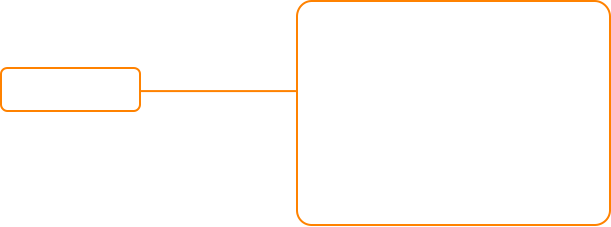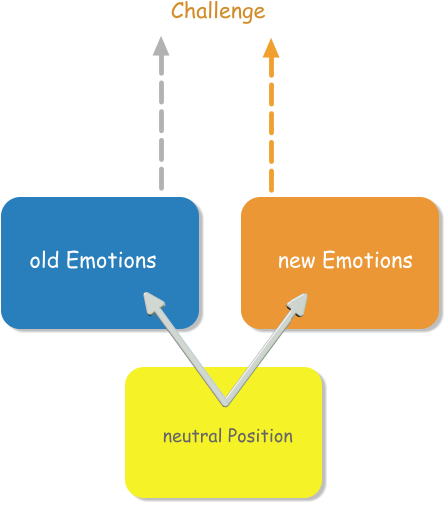Emergency Emo-Step
®

Dealing with difficult emotions
How to turn your team
into the boss


- The 6 Hurdles
- The Elements
- What are the Elements
- Culture Stage Model
- Gut, Head or Herart Process
- Culture Change
- List of Feelings and Needs
- Emergency Emo-Step
- Four Step Circle
- NVC Magic Circle
- Utopia Magic Circle
- Utopia and Vision
- No-Goes and Must-Haves
- Pain Points
- Consensus
- Requirement Lists
- NVC-plus Strategy
- NVC-plus Matrix
- Discourse
- Card Set
- Download-Tool-Depot
- FAQs
- Events
- Media

6 Hurdles to Self-Organization
Chapter 10 - Emergency Emo-Step


Home / hurdle 2: feelings / emergency emo-step

Emo-Step®
is
one
of
the
methodical
mat
processes
that
are
usually
performed
on
colored
floor
mats.
They
can
be
used
to
program
the
subconscious
to
a
certain
degree.
Emo-Step®
was
developed
by
Gabriel
Fritsch
in
2008
and
has
since
proven
itself
in
countless
coaching
sessions.
We
would
like
to
describe
a
short
form
here
as
the
"Emergency
Emo-Step®",
because
sometimes
you
are
a
little
confused,
stressed
or
turned
off
and
all
it
takes
is
a
little
impulse
to
get
you
back
on
a
constructive
and
visionary
track.
This
Emo-Step®
short
form
may
not
always
help,
but
it
usually
does
and
in
an
emergency
you
always
have
one
more
card
in
the deck.
Feelings
begin
as
unconscious
emotional
impulses,
which
generally
take
effect
more
quickly
than
thoughts
when
problems
arise
and
therefore
fall
back
on
the
evolutionarily
older
areas
of
the
brain,
i.e.
the
brain
stem
and
the
limbic
system.
So
not
only
will
we
hardly
be
able
to
prevent
emotions
with
our
thoughts,
we
will
also
find
it
difficult
to
change
or
direct
them
logically.
Emotions,
on
the
other
hand,
have
a
significant
influence
on
our
thoughts
and
sometimes
drive
them
into
a
thought
carousel.
The
neuronal
system
responsible
for
emotions
cannot
itself
think
logically
and
the
cognitive
center
in
the
brain
cannot
feel.
So
how
are
they
supposed
to
communicate
with
each
other?
Nevertheless,
we
suspect
that
if
we
go
into
a
meeting
with
fear,
defiance
and
indignation,
we
won't
have
the
best
fuel
in
the
tank.
So
what
can
we
do?
Because
even
if
strong
emotions
are
vital
for
non-thinking
creatures,
they
are
often
a
problem
for
a
thinking
being.
Emotions
are
vitality,
but
if
our
vitality
works
against
our
goals,
this
is
unfavorable.
Freedom
therefore
means the possibility of being able to change one's own emotions logically.
The
solution
for
life-serving
emotional
reprogramming
lies
quite
simply
in
rapidly
changing
emotional
experiences
in
a
playful
setting.
We
place
three
doormats,
sheets
of
paper,
advertising
brochures
or
something
else
on
the
floor,
as
shown
in
the
graphic.
If
we
don't
have
anything
to
hand,
we
look
for
tiles
or
simply
imagine the three Emo-Step® mats.
We
start
at
the
central
yellow
position.
Here
we
are
not
feeling,
just
observing,
and
from
here
we
switch
between
the
two
emotional
experience
mats
left/blue
and
right/orange,
on
which
we
then
feel.
This
gives
us
our
setting
for
an
alternating
emotional
experience
with
regard
to
exactly
one
problem.
We
think
about
what
the
core
of
the
problem
could
be
that
is
causing
these
unpleasant
feelings
in
us.
First
we
go
to
the
left
side,
to
the
blue
experience
mat.
There
we
experience
the
emotions
that
we
feel
automatically
in
relation
to
our
problem.
They
have
arisen
from
what
we
have
experienced
so
far
and
with
them
we
now
look
ahead
to
what
still
lies
ahead
of
us.
Here
we
briefly
experience
how
we
feel
in
this
position
and
then
step
back
onto
the
yellow
mat.
(So
that
you
know
what
you
are
feeling,
you
can
read
through
the
list
of
feelings
in
classic
non-violent
communication
.
You will immediately notice which words resonate with you).
Every
emotion
manages
certain
behavioral
options.
With
anger,
we
can
shout
at
someone
or
hold
back
with
difficulty.
We
can
also
pull
down
the
corners
of
our
mouth
and
furrow
our
brow.
What
we
find
more
difficult,
however,
is
to
smile,
show
humor,
remain
open
and
hug
someone.
But
what
if
the
behavioral
options
available
to
us
because
of
our
negative
feelings
are
unlikely
to
get
us
where
we
want
to
go?
Do
we
then
prefer
to
stay
true
to
our
emotions
or
our
goals?
In
other
words,
do
we
remain
true
to
ourselves
if
we
remain
stuck
in
the
emotional
dead
end
while
defiance,
shame,
rebellion,
melancholy,
anger
or
fears
prompt
all
kinds
of
foolishness,
or
do
we
remain
true
to
ourselves
if
we
consistently
pursue
our
visionary
path?
That
is
what we need to test out.
To
do
this,
we
need
the
orange
Emo-Step®
mat
on
the
right.
This
stands
for
positive
emotions
such
as
courage,
confidence,
openness
and
warmth,
lightness,
willpower,
etc.
Think
about
which
feelings
and
qualities
would
help
you
to
reach
your
maximum
potential
in
relation
to
the
problem
and
then
stand
on
them.
We
only
stay
on
this
right
mat
for
a
short
time
and
then
switch
back
to
the
left/blue
mat
position
via
the
central
position.
There
we
experience
the
initial
state
again.
We
think
about
the
challenge
ahead
of
us.
How
will
we
master
it
with
these
negative
feelings?
Then
we
switch
back
to
the
right/orange
position
via
the
central yellow position and feel what is possible for us with these positive feelings.
We
repeat
this
several
times.
Ideally,
the
limbic
system
will
switch
to
the
better
emotions
because
this
directly
experienced
comparison
makes
us
prefer
to
rely
on
them
rather
than
on
the
old
impulses.
True
to
the
motto:
if
we
are
already
in
external
difficulties,
we
don't
need
emotional
chaos
on
the
inside.
One
of
these problems is superfluous and you can guess which one it might be.
We
can
also
ask
ourselves
whether
our
problem
is
a
dangerous
or
just
an
unpleasant
situation.
Many
things
may
feel
dangerous,
but
our
life
and
limb
are
not
in
danger.
We
then
also
know
whether
we
need
to
reach
for
the
bottom
drawer
of
behavior
to
defend
our
body
and
life
with
claws
and
teeth.
After
all,
in
a
difficult
meeting
with
disagreeable
colleagues
or
a
risky
large
group
presentation,
it
would
of
course
make
no
sense
at
all
to
act
like
Rambo
just
because
our
emotions
have
mistakenly
loaded
the
armor-piercing
ammunition
into
the
magazine
and
not
the
confetti.
With
gentleness,
patience
and
persistence,
we
will
make
good
progress
in
99%
of
cases,
as
the
challenges
are
rarely
dangerous,
but
mostly
just
unpleasant.
And if things don't work out, good feelings are better than bad ones.
With
Emo-Step®,
we
give
the
limbic
system
the
chance
to
organize
itself
intelligently
by
alternately
experiencing
two
different
emotional
options
with
regard
to
the
challenge.
After
four
to
eight
mat
changes,
we
realize
that
we
no
longer
want
to
enter
the
left/blue
position
with
the
worse
option.
We
feel
a
resistance
that
stems
from
the
fact
that
our
emotional
control
center
wants
to
switch
to
the
other
side
in
order
to
channel
the
better
feelings
into
the
creative
process.
We
then
make
two
or
three
switches
from
left
to
right
anyway,
and
the
case
is
pretty
much
closed.
The
whole
thing
only
takes
a
few
minutes.
The
most
difficult
thing
is
to
allow
the
positive
emotions
at
the
beginning
so
that
you
can
experience
them
as
an
option,
even
if it seems "illogical".
If
that
doesn't
work,
you
would
have
to
go
deeper
than
this
short
form.
That
can
happen
and
needn't
worry
anyone.
Instead
of
Emo-Step,
take
three
deep
breaths,
think
of
someone
you
really
like,
promise
yourself
something
nice
as
a
reward
afterwards
-
if
you
like,
say
a
prayer
-
and
off
you
go.
You
are
also
welcome
to
contact
us in confidence.

Successful
cooperation
is
both
a
path
and
a
goal.
Good
methods
and
tools
make
it
much
easier
for
a
team
to
organize
itself.
Encourage
your
team
to
take
the
first
steps
in
this
direction
and
experience the difference.

Every team, start-up, or company must overcome these six hurdles if it wants to organize itself
collegially in order to successfully manage projects from within the community.

Emergency Emo-Step
®






d) Emergency Emo-Step

Dealing with difficult emotions
Chapter 10 - Emergency Emo-Step


- The 6 Hurdles
- The Elements
- What are the Elements
- Culture Stage Model
- Gut, Head or Herart Process
- Culture Change
- List of Feelings and Needs
- Requirement Lists
- NVC Magic Circle
- Utopia Magic Circle
- Emergency Emo-Step
- Four Step Circle
- Utopia and Vision
- No-Goes and Must-Haves
- Pain Points
- Consensus
- NVC-plus Strategy
- NVC-plus Matrix
- Discourse
- Card Set
- Download-Tool-Depot
- FAQs
- Events
- Media
Successful
cooperation
is
both
a
path
and
a
goal.
Good
methods
and
tools
make
it
much
easier
for
a
team
to
organize
itself.
Encourage
your
team
to
take
the
first
steps
in
this
direction
and
experience
the
difference.
Emo-Step®
is
one
of
the
methodical
mat
processes
that
are
usually
performed
on
colored
floor
mats.
They
can
be
used
to
program
the
subconscious
to
a
certain
degree.
Emo-Step®
was
developed
by
Gabriel
Fritsch
in
2008
and
has
since
proven
itself
in
countless
coaching
sessions.
We
would
like
to
describe
a
short
form
here
as
the
"Emergency
Emo-Step®",
because
sometimes
you
are
a
little
confused,
stressed
or
turned
off
and
all
it
takes
is
a
little
impulse
to
get
you
back
on
a
constructive
and
visionary
track.
This
Emo-
Step®
short
form
may
not
always
help,
but
it
usually
does
and
in
an
emergency
you
always
have
one
more
card in the deck.
Feelings
begin
as
unconscious
emotional
impulses,
which
generally
take
effect
more
quickly
than
thoughts
when
problems
arise
and
therefore
fall
back
on
the
evolutionarily
older
areas
of
the
brain,
i.e.
the
brain
stem
and
the
limbic
system.
So
not
only
will
we
hardly
be
able
to
prevent
emotions
with
our
thoughts,
we
will
also
find
it
difficult
to
change
or
direct
them
logically.
Emotions,
on
the
other
hand,
have
a
significant
influence
on
our
thoughts
and
sometimes
drive
them
into
a
thought
carousel.
The
neuronal
system
responsible
for
emotions
cannot
itself
think
logically
and
the
cognitive
center
in
the
brain
cannot
feel.
So
how
are
they
supposed
to
communicate
with
each
other?
Nevertheless,
we
suspect
that
if
we
go
into
a
meeting
with
fear,
defiance
and
indignation,
we
won't
have
the
best
fuel
in
the
tank.
So
what
can
we
do?
Because
even
if
strong
emotions
are
vital
for
non-
thinking
creatures,
they
are
often
a
problem
for
a
thinking
being.
Emotions
are
vitality,
but
if
our
vitality
works
against
our
goals,
this
is
unfavorable.
Freedom
therefore
means
the
possibility
of
being
able
to
change one's own emotions logically.
The
solution
for
life-serving
emotional
reprogramming
lies
quite
simply
in
rapidly
changing
emotional
experiences
in
a
playful
setting.
We
place
three
doormats,
sheets
of
paper,
advertising
brochures
or
something
else
on
the
floor,
as
shown
in
the
graphic.
If
we
don't
have
anything
to
hand,
we
look
for
tiles
or
simply imagine the three Emo-Step® mats.
We
start
at
the
central
yellow
position.
Here
we
are
not
feeling,
just
observing,
and
from
here
we
switch
between
the
two
emotional
experience
mats
left/blue
and
right/orange,
on
which
we
then
feel.
This
gives
us
our
setting
for
an
alternating
emotional
experience with regard to exactly one problem.
We
think
about
what
the
core
of
the
problem
could
be
that
is
causing
these
unpleasant
feelings
in
us.
First
we
go
to
the
left
side,
to
the
blue
experience
mat.
There
we
experience
the
emotions
that
we
feel
automatically
in
relation
to
our
problem.
They
have
arisen
from
what
we
have
experienced
so
far
and
with
them
we
now
look
ahead
to
what
still
lies
ahead
of
us.
Here
we
briefly
experience
how
we
feel
in
this
position
and
then
step
back
onto
the
yellow
mat.
(So
that
you
know
what
you
are
feeling,
you
can
read
through
the
list
of
feelings
in
classic
non-violent
communication
.
You
will
immediately
notice
which
words
resonate
with you).
Every
emotion
manages
certain
behavioral
options.
With
anger,
we
can
shout
at
someone
or
hold
back
with
difficulty.
We
can
also
pull
down
the
corners
of
our
mouth
and
furrow
our
brow.
What
we
find
more
difficult,
however,
is
to
smile,
show
humor,
remain
open
and
hug
someone.
But
what
if
the
behavioral
options
available
to
us
because
of
our
negative
feelings
are
unlikely
to
get
us
where
we
want
to
go?
Do
we
then
prefer
to
stay
true
to
our
emotions
or
our
goals?
In
other
words,
do
we
remain
true
to
ourselves
if
we
remain
stuck
in
the
emotional
dead
end
while
defiance,
shame,
rebellion,
melancholy,
anger
or
fears
prompt
all
kinds
of
foolishness,
or
do
we
remain
true
to
ourselves
if
we
consistently
pursue
our
visionary
path? That is what we need to test out.
To
do
this,
we
need
the
orange
Emo-Step®
mat
on
the
right.
This
stands
for
positive
emotions
such
as
courage,
confidence,
openness
and
warmth,
lightness,
willpower,
etc.
Think
about
which
feelings
and
qualities
would
help
you
to
reach
your
maximum
potential
in
relation
to
the
problem
and
then
stand
on
them.
We
only
stay
on
this
right
mat
for
a
short
time
and
then
switch
back
to
the
left/blue
mat
position
via
the
central
position.
There
we
experience
the
initial
state
again.
We
think
about
the
challenge
ahead
of
us.
How
will
we
master
it
with
these
negative
feelings?
Then
we
switch
back
to
the
right/orange
position
via
the
central
yellow
position
and
feel
what
is
possible
for
us
with these positive feelings.
We
repeat
this
several
times.
Ideally,
the
limbic
system
will
switch
to
the
better
emotions
because
this
directly
experienced
comparison
makes
us
prefer
to
rely
on
them
rather
than
on
the
old
impulses.
True
to
the
motto:
if
we
are
already
in
external
difficulties,
we
don't
need
emotional
chaos
on
the
inside.
One
of
these
problems
is
superfluous
and
you
can
guess
which one it might be.
We
can
also
ask
ourselves
whether
our
problem
is
a
dangerous
or
just
an
unpleasant
situation.
Many
things
may
feel
dangerous,
but
our
life
and
limb
are
not
in
danger.
We
then
also
know
whether
we
need
to
reach
for
the
bottom
drawer
of
behavior
to
defend
our
body
and
life
with
claws
and
teeth.
After
all,
in
a
difficult
meeting
with
disagreeable
colleagues
or
a
risky
large
group
presentation,
it
would
of
course
make
no
sense
at
all
to
act
like
Rambo
just
because
our
emotions
have
mistakenly
loaded
the
armor-piercing
ammunition
into
the
magazine
and
not
the
confetti.
With
gentleness,
patience
and
persistence,
we
will
make
good
progress
in
99%
of
cases,
as
the
challenges
are
rarely
dangerous,
but
mostly
just
unpleasant.
And
if
things
don't
work
out,
good
feelings
are better than bad ones.
With
Emo-Step®,
we
give
the
limbic
system
the
chance
to
organize
itself
intelligently
by
alternately
experiencing
two
different
emotional
options
with
regard
to
the
challenge.
After
four
to
eight
mat
changes,
we
realize
that
we
no
longer
want
to
enter
the
left/blue
position
with
the
worse
option.
We
feel
a
resistance
that
stems
from
the
fact
that
our
emotional
control
center
wants
to
switch
to
the
other
side
in
order
to
channel
the
better
feelings
into
the
creative
process.
We
then
make
two
or
three
switches
from
left
to
right
anyway,
and
the
case
is
pretty
much
closed.
The
whole
thing
only
takes
a
few
minutes.
The
most
difficult
thing
is
to
allow
the
positive
emotions
at
the
beginning
so
that
you
can
experience
them
as
an
option, even if it seems "illogical".
If
that
doesn't
work,
you
would
have
to
go
deeper
than
this
short
form.
That
can
happen
and
needn't
worry
anyone.
Instead
of
Emo-Step,
take
three
deep
breaths,
think
of
someone
you
really
like,
promise
yourself
something
nice
as
a
reward
afterwards
-
if
you
like,
say
a
prayer
-
and
off
you
go.
You
are
also
welcome to
contact
us in confidence.








































